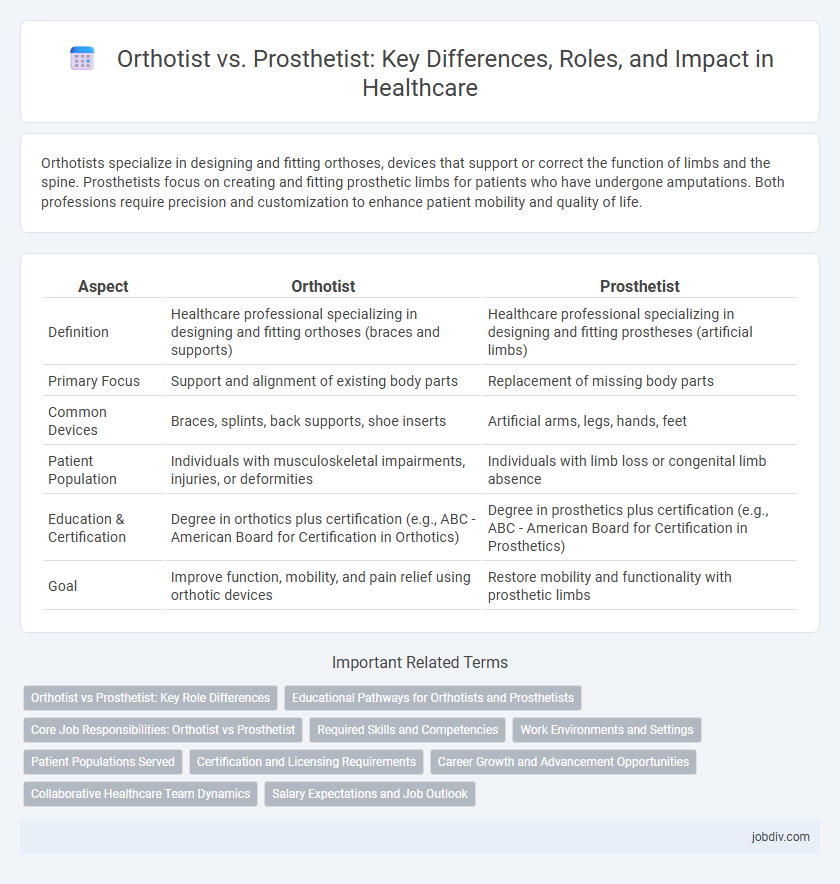Orthotists specialize in designing and fitting orthoses, devices that support or correct the function of limbs and the spine. Prosthetists focus on creating and fitting prosthetic limbs for patients who have undergone amputations. Both professions require precision and customization to enhance patient mobility and quality of life.
Table of Comparison
| Aspect | Orthotist | Prosthetist |
|---|---|---|
| Definition | Healthcare professional specializing in designing and fitting orthoses (braces and supports) | Healthcare professional specializing in designing and fitting prostheses (artificial limbs) |
| Primary Focus | Support and alignment of existing body parts | Replacement of missing body parts |
| Common Devices | Braces, splints, back supports, shoe inserts | Artificial arms, legs, hands, feet |
| Patient Population | Individuals with musculoskeletal impairments, injuries, or deformities | Individuals with limb loss or congenital limb absence |
| Education & Certification | Degree in orthotics plus certification (e.g., ABC - American Board for Certification in Orthotics) | Degree in prosthetics plus certification (e.g., ABC - American Board for Certification in Prosthetics) |
| Goal | Improve function, mobility, and pain relief using orthotic devices | Restore mobility and functionality with prosthetic limbs |
Orthotist vs Prosthetist: Key Role Differences
Orthotists specialize in designing, fitting, and maintaining orthoses to support or correct musculoskeletal deformities and improve limb function. Prosthetists focus on creating and fitting prosthetic limbs to replace missing body parts, enhancing mobility and independence for amputees. Both professions require expertise in biomechanics and patient care, but orthotists concentrate on limb support devices, while prosthetists manage artificial limb replacements.
Educational Pathways for Orthotists and Prosthetists
Orthotists require a master's degree in orthotics and prosthetics or a related field, often followed by a clinical residency lasting 12 to 18 months to gain hands-on experience in designing and fitting orthopedic braces. Prosthetists follow a similar educational pathway, typically completing a master's degree in prosthetics and orthotics accredited by the Commission on Accreditation of Allied Health Education Programs (CAAHEP) and a clinical internship focused on limb prosthesis fabrication and fitting. Both professions require successful passing of certification exams from the American Board for Certification in Orthotics, Prosthetics & Pedorthics (ABC) to practice.
Core Job Responsibilities: Orthotist vs Prosthetist
Orthotists specialize in designing, fitting, and maintaining orthoses such as braces and supports to improve patient mobility and alleviate musculoskeletal issues. Prosthetists focus on creating and fitting prosthetic limbs for patients who have lost extremities due to injury, disease, or congenital conditions, ensuring functionality and comfort. Both professionals collaborate with healthcare teams to customize devices that enhance patient rehabilitation and quality of life.
Required Skills and Competencies
Orthotists require expertise in biomechanics, anatomy, and materials science to design and fit supportive devices that improve patient mobility and function. Prosthetists must possess advanced knowledge of limb anatomy, rehabilitation techniques, and prosthetic technology to create customized artificial limbs that restore mobility and enhance quality of life. Both professions demand strong patient communication, problem-solving skills, and proficiency in using CAD software for device fabrication.
Work Environments and Settings
Orthotists primarily work in hospitals, rehabilitation centers, and outpatient clinics where they design, fabricate, and fit orthotic devices to support or correct musculoskeletal deformities. Prosthetists operate in similar health care settings but often extend their practice to specialized prosthetic clinics and private practices focusing on fitting artificial limbs for amputees. Both professionals collaborate closely with physicians, physical therapists, and patients in multidisciplinary environments to optimize mobility and functional outcomes.
Patient Populations Served
Orthotists primarily serve patients with musculoskeletal impairments requiring braces or supports for conditions such as scoliosis, cerebral palsy, and post-stroke rehabilitation. Prosthetists focus on individuals who have experienced limb loss due to trauma, vascular disease, or congenital limb deficiencies, providing custom artificial limbs. Both specialists play crucial roles in improving mobility and quality of life for diverse patient populations facing physical disabilities.
Certification and Licensing Requirements
Orthotists and prosthetists must obtain certification through the American Board for Certification in Orthotics, Prosthetics & Pedorthics (ABC) or the Board of Certification/Accreditation (BOC), which requires a master's degree and completion of a residency. Licensing requirements vary by state, with most states mandating individual licensure to legally practice. Continuous education is essential for both professionals to maintain certification and comply with state regulatory standards.
Career Growth and Advancement Opportunities
Orthotists and prosthetists experience strong career growth due to increasing demand for custom orthopedic and prosthetic devices driven by aging populations and technological advancements. Opportunities for advancement include specialization in areas such as pediatric orthotics or advanced prosthetic technology, as well as roles in clinical management, research, and education. Certification and continued education enhance prospects for leadership positions and higher salaries in this evolving healthcare field.
Collaborative Healthcare Team Dynamics
Orthotists and prosthetists play vital roles within collaborative healthcare team dynamics, each specializing in distinct yet complementary areas: orthotists focus on designing and fitting orthoses to support or correct musculoskeletal functions, while prosthetists create and fit prosthetic limbs to restore mobility and functionality. Effective communication and coordination between orthotists, prosthetists, physicians, physical therapists, and other healthcare professionals ensure personalized patient care and optimized rehabilitation outcomes. Integrating their expertise within multidisciplinary teams enhances treatment planning, accelerates recovery, and improves quality of life for patients with limb loss or musculoskeletal impairments.
Salary Expectations and Job Outlook
Orthotists typically earn a median annual salary of around $70,000, while prosthetists often command higher wages, averaging approximately $85,000 due to the specialized nature of fitting prosthetic limbs. The job outlook for both professions is positive, with a projected growth rate of about 10% from 2022 to 2032, driven by an aging population and increased demand for rehabilitation services. Employment opportunities are strongest in hospitals, outpatient care centers, and specialized clinics, where advancements in medical technology continue to expand their roles.
Orthotist vs Prosthetist Infographic

 jobdiv.com
jobdiv.com